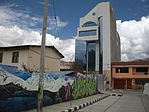This article needs additional citations for verification. (January 2011) |
Huaraz
San Sebastián de Huaraz | |
|---|---|
City | |
Top: White mountain range, Second left: La Soledad neighborhood, Second right: Gamarra Avenue, Third left: Residential street in Huarupampa suburb, Third right: Building development, Bottom: Cultural Center and Municipal Theater | |
| Motto(s): The noble and generous City, Capital of International Friendship, Natural Paradise of the World | |
| Coordinates: 9°32′S 77°32′W / 9.533°S 77.533°W | |
| Country | |
| Region | Ancash |
| Province | Huaraz |
| Founded | 20 January 1574 |
| Government | |
| • Type | Democracy |
| • Mayor | Eliseo Rori Mautino Ángeles (2019–2022) |
| Area | |
| • Total | 370.03 km2 (142.87 sq mi) |
| Elevation | 3,052 m (10,013 ft) |
| Population (2017) | |
| • Total | 118,836 |
| • Estimate (2015)[1] | 127,041 |
| • Density | 320/km2 (830/sq mi) |
| Time zone | UTC-5 (PET) |
| • Summer (DST) | UTC-5 (PET) |
| Area code | 43 |
| Website | www.munihuaraz.gob.pe |
Huaraz ([waˈɾas]) (from Quechua: Waraq or Warash, "dawn"), formerly designated as San Sebastián de Huaraz, is a city in Peru. It is the capital of the Ancash Region (State of Ancash) and the seat of government of Huaraz Province. The urban area's population is distributed over the districts of Huaraz and Independencia. The city is located in the middle of the Callejon de Huaylas valley and on the right side of the Santa river. The city has an elevation of approximately 3050 meters above sea level. The built-up area covers 8 square kilometers and has a population of 120,000 inhabitants, making it the second largest city in the central Peruvian Andes after the city of Huancayo. It is the 22nd largest city in Peru. Huaraz is the seat of the province's Roman Catholic Bishop and the site of the cathedral.
Huaraz is the main financial and trade center of the Callejón de Huaylas and the main tourist destination of Ancash region. Moreover, it is one of the biggest towns in the Peruvian Andes. Huaraz is the main destinations for winter sports and adventure. Many visitors from around the world come to the city for practicing sports as climbing, hiking, mountain biking and snowboarding, and also to visit the glaciers and mountains of the Cordillera Blanca, mainly Mount Huascarán, which is considered the tallest mountain in the tropics, all of them located in Huascarán National Park which UNESCO declared a nature world heritage site in 1985.
The city was founded before the Inca Empire when humans settled around the valley of the Santa River and Qillqay. Its Spanish occupation occurred in 1574 as a Spanish-indigenous reducción. During the wars for the independence of Peru, the whole city supported the Liberating Army with food and guns, earning the city the title of "Noble and Generous City" granted by Simón Bolívar. In 1970, 95% of the city was destroyed by an earthquake that damaged much of Ancash Region. 25,000 people died. The city received much foreign assistance from many countries. For this reason the city was named a capital of International Friendship.
The main economic activities in the city are farming, commerce and tourism. Since Huaraz has tourist infrastructure supporting the Ancash Highlands, the city is the main point of arrival for practitioners of adventure sports and mountaineering. Along with the snowy peaks of the Cordillera Blanca, one can visit archaeological sites like Chavín de Huantar and the eastern highlands of Ancash, known as Conchucos.
- ^ Perú: Población estimada al 30 de junio y tasa de crecimiento de las ciudades capitales, por departamento, 2011 y 2015. Perú: Estimaciones y proyecciones de población total por sexo de las principales ciudades, 2012–2015 (Report). Instituto Nacional de Estadística e Informática. March 2012. Retrieved 3 June 2015.








